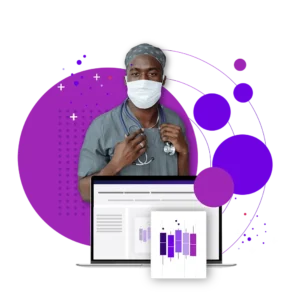Numerous data challenges exist for life science organizations including limited access, slow timelines, cumbersome processes, and regulatory requirements. Limited access to appropriate data often forces research projects to pivot in a new direction with new data requirements.
Challenges for life science research include:
-
Acquiring accurate, highly-detailed information
-
Difficulty collaborating with and across organizations due to privacy regulations
-
Fully utilizing unstructured data
Understanding these pain points is critical. Streamlining the process for pharmaceutical and biotechnology companies provides instant insights to project feasibility, the ability to innovate with reduced risk, and find life saving therapies at accelerated speeds.
Data Granularity
Granular data can be aggregated and disaggregated to meet the needs of different research projects, and can be easily merged with data from different sources, effectively mined, and analyzed.
With more data at hand, researchers can mold expansive information into populations of interest, adding and removing properties, until an appropriate cohort of interest is defined.
Dynamically Explore Granular Data
Data granularity is a massive challenge for both healthcare and life science organizations who require detailed information about individual patients as opposed to aggregated insights.
Examples:
-
Capture a disease trajectory. This includes patient population, staging of the disease over time, treatment lines used (including surgeries), response to those treatments, and outcomes (e.g., remission, relapse, and death).
-
Compare drug efficacy with regard to health economics and other outcomes. Using the available data, one could determine, for example, if the prevention of costly emergency department visits and hospital admissions justifies the use of a relatively expensive drug.
-
Find and mitigate clinical variation in healthcare workflows. When appropriate, guidelines and clinical practices could be standardized such that care pathways are made more efficient without compromising on standards.
Detailed data typically include entire electronic health record (EHR) systems and everything contained within, including all demographics, procedures, diagnoses, and medications — some of which date back as far as 30 years. In some systems, financial data, including costs or claims related to individual patients and events, are included.
For example, data might include:
-
Demographics
-
Procedures
-
Diagnoses
-
Lab Results
-
Medications
-
Physician Notes
-
Pathology Reports
-
Patient Surveys
-
Genetic Markers
-
Imaging Results
-
Utilization and Cost Data
-
Social Determinants of Health
-
Administrative Documentation
Synthetic Data Solves Access and Privacy Challenges
The solution for solving these access and privacy challenges is synthetic data.
Synthetic data is non-reversible, artificially created data that replicates the statistical characteristics and correlations of real-world, raw data. Utilizing both discrete and non-discrete variables of interest, synthetic data does not contain identifiable information because it uses a statistical approach to create a brand-new dataset.
“MDClone offers powerful synthetic data capabilities and enables users to explore robust, organized data to get the information they need without barriers or limitations. ”
Life sciences companies can use synthetic data to conduct RWE studies as though real patient data was being used.
Solutions for Structured and Unstructured Data
Data can be either structured or unstructured. Structured data includes pieces of information like diagnoses, medication orders, lab results, procedures, imaging, and more. Unstructured data — such as medical notes, imaging reports, and patient surveys, to name a few — are difficult to study without lots of manual review.
Often, data that are essential for research are in unstructured and cumbersome formats. Healthcare systems can use Natural Language Processing (NLP) to extract structured data from unstructured texts and documents. Conversion to a structured, queryable format enriches and fully aggregates the data into a single source which can be easily accessed and analyzed by life science companies.
Conclusion
With granular data available, users have the ability to study some of the most complex data projects in healthcare. Synthetic data, an on-demand repository of robust, detailed data, and NLP capabilities creates a powerhouse solution for RWE and life science research.
With data readily available on-demand, with significant detail, life science organizations can adjust project requirements on the fly, working with expert teams from around the world, to accelerate the projects such as clinical trial development, drug discovery and development, research and development, therapeutics, and innovation with speed and confidence.
Ready to See Our Powerful Platform in Action?
Discover the power of dynamic data exploration at your fingertips and unlock the true potential of your healthcare data.











